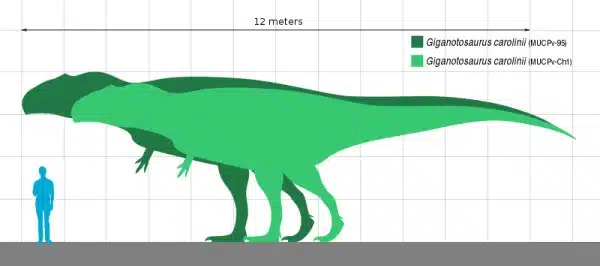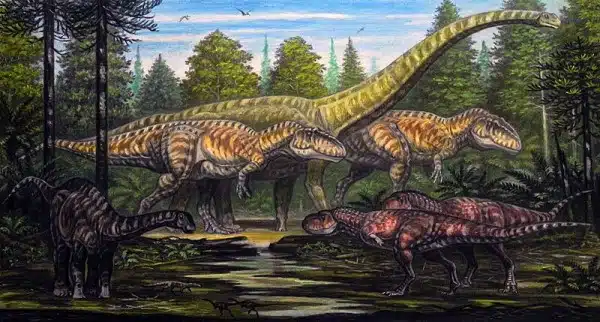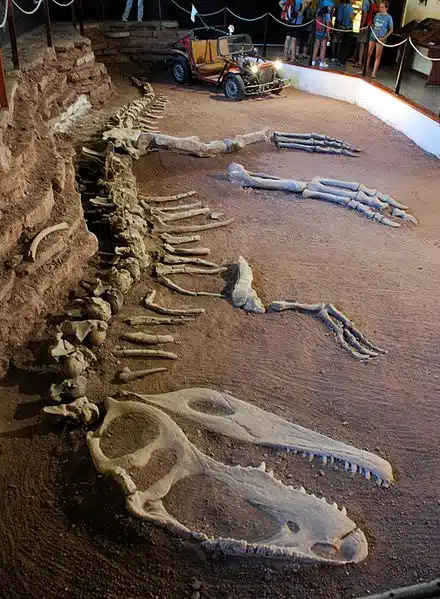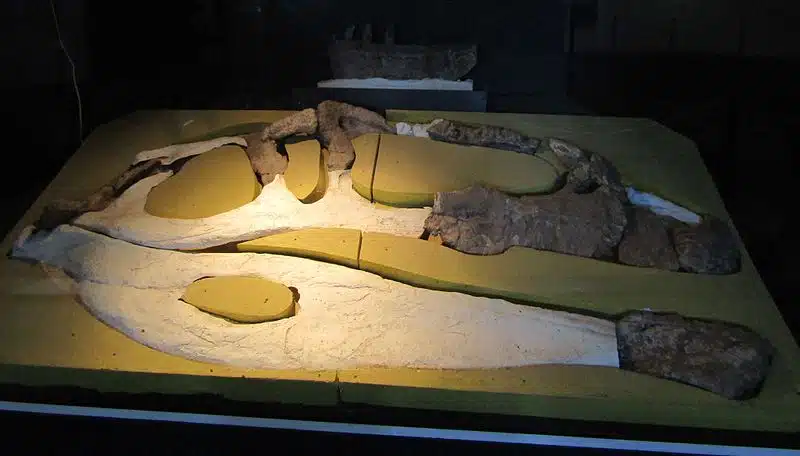Let’s embark on a journey back in time, to an era when colossal creatures roamed the earth. Among these ancient giants was the Giganotosaurus. This dinosaur carries a name that evokes images of a formidable predator from a bygone world. This dinosaur hails from the Late Cretaceous Period, a time of significant changes and diversifications in the dinosaur world.
The Giganotosaurus stands out not just for its size but also for the mysteries that still surround it. Discovered relatively recently in 1993, this dinosaur has sparked curiosity and fascination among paleontologists and enthusiasts alike. Its discovery in Patagonia, Argentina opened a new chapter in our understanding of the dinosaur fauna of the Southern Hemisphere. As we delve into the world of this magnificent creature, we’ll explore its origins, characteristics, and the environment it once called home.
Giganotosaurus Key Facts
| Keyword | Fact |
|---|---|
| Pronunciation | gig-an-OH-toe-SORE-us |
| Meaning of name | Giant Southern lizard |
| Group | Theropod |
| Type Species | Giganotosaurus carolinii |
| Diet | Carnivore |
| When it Lived | 99.6 to 93.5 MYA |
| Period | Late Cretaceous |
| Epoch | Late/Upper Cenomanian to the top of the Early/Lower Cenomanian |
| Length | 39.0 to 43.0 feet |
| Height | Approximately 13.0 feet at hips |
| Weight | 4.6 to 15.2 tons |
| Mobility | Moved on two legs |
| First Discovery | 1993 by Rubén Carolini |
| Described by | 1995 by Rodolfo Coria and Leonardo Salgado |
| Holotype | MUCPv-Ch1 |
| Location of first find | Villa El Chocón, Neuquén, Patagonia, Argentina |
Giganotosaurus Origins, Taxonomy and Timeline
The name of the Giganotosaurus is derived from the Greek words gigas for “giant”, notos for “south wind”, and saurus for “lizard/reptile”. This perfectly encapsulates the essence of this colossal creature. Its name not only reflects its enormous size but also its geographical roots in the southern lands.

Belonging to the Theropod group, specifically the Carcharodontosaurid family, Giganotosaurus carolinii stands as the type species of its genus. This classification places it among the large, bipedal carnivores that once dominated the prehistoric landscapes.
The timeline spans the Late Cretaceous Period, specifically from the Late Cenomanian to the Early/Lower Cenomanian Epochs. This places its existence approximately between 99.6 and 93.5 million years ago, a period marked by significant evolutionary developments among dinosaurs.
Listen to Pronunciation
Discovery & Fossil Evidence
The tale of this dinosaur’s discovery begins in 1993, when Rubén Carolini, an amateur fossil hunter, stumbled upon its remains in Villa El Chocón, Neuquén in the Patagonian region of Argentina. This momentous find was later described in 1995 by paleontologists Rodolfo Coria and Leonardo Salgado.
The holotype, designated as MUCPv-Ch1, provided a tantalizing glimpse into the anatomy of this massive predator. While subsequent finds have been scarce, each discovery has contributed valuable pieces to the puzzle and enhanced our understanding of this enigmatic dinosaur.
- Skull reconstruction of Giganotosaurus in front view showing how narrow it is.
- Reconstructed skeleton, EBPM
- Reconstructed skeleton, possibly with a proportionally too long skull, Fernbank Museum of Natural History
- A Giganotosaurus skull cast
- Fossil teeth of Giganotosaurus carolinii exhibited at the Ernesto Bachmann Paleontological Museum, Villa El Chocón, Neuquén, Argentina.
- The Natural Science Museum at El Chocón, in the northwestern Argentine Patagonia (the Comahue region). Fossil of Giganotosaurus carolinii
- Original remains of the right side of the skull of Giganotosaurus carolinii in the Ernesto Bachmann Paleontological Museum (seen from another angle).
- Reconstructed Giganotosaurus carolinii skeleton, Natural History Museum, Helsinki.
The fossils unearthed so far include bones from various parts of the body, offering insights into its physical structure. The degree of preservation varies but each find has been instrumental in piecing together the appearance and lifestyle of the Giganotosaurus.
Giganotosaurus Size and Description
Let’s delve into the dimensions of Giganotosaurus, a creature whose size has both fascinated and puzzled scientists. Despite the challenges in determining its exact measurements, this is undeniably one of the largest terrestrial carnivores to have ever walked the Earth.
Short description of Giganotosaurus
Envision a behemoth, its powerful legs carrying it across ancient landscapes. The Giganotosaurus possessed a formidable skull, measuring between 5.0 to 5.9 feet in length, housing a deadly arsenal of teeth. Its robust body was supported by strong limbs and a lengthy, muscular tail, all speaking to its prowess as a top predator of its time.
Size and Weight of Type Species

The most complete specimen of Giganotosaurus suggests a staggering length of 39.0 to 43.0 feet. A particularly intriguing dentary bone is believed to belong to an even larger individual, which hints at a possible length of 43.0 feet. Estimates vary widely when it comes to weight, ranging from 4.6 to 15.2 tons.
Comparisons with the iconic Tyrannosaurus have sparked debates among researchers. Some believe Giganotosaurus to have been larger, potentially dethroning Tyrannosaurus as the largest Theropod. Others argue that they were roughly equal in size, with some of the larger size estimates for Giganotosaurus being considered exaggerated. Regardless of its exact standing in the size rankings, there’s no denying that Giganotosaurus was a colossal predator and a true titan of the Late Cretaceous.
Giganotosaurus Illustration Sketch
The Dinosaur in Detail
Giganotosaurus stands out for several unique features that distinguish it from other Theropods. Its skull, for instance, was proportionally large and equipped with a set of teeth designed for slicing rather than crushing. This dental arrangement suggests a specialized hunting strategy that possibly targeted large Sauropods or scavenging on carcasses. Its relatively long legs would likely have not been ideal for high-speed chases.
Another notable aspect is its brain size relative to its body. While not particularly large, it was sufficient for the demands of its predatory lifestyle. This balance between brain size and body mass indicates a level of adaptability and survival instinct that served Giganotosaurus well in its environment.
The fossil record, though limited, has provided glimpses into the life of this ancient predator. Notable specimens have shed light on its growth patterns, behavior, and ecological role, contributing significantly to our understanding of the Late Cretaceous ecosystems.
The Ultimate Dino Quiz
Do you want to test your knowledge on dinosaurs? Then try this Ultimate Dino Quiz! Don’t worry if you get some of the answers wrong, and look at it as an opportunity to refresh and improve your knowledge!
Don’t forget to try our other games as well!
Interesting Points about Giganotosaurus
- As one of the largest Theropods, this dinosaur is a top predator alongside notable hunters such as Tyrannosaurus, Tyrannotitan, and Allosaurus.
- The size and weight estimates of this dinosaur continue to be a debate among scientists due to its incomplete fossil record.
- Its name is a nod to both its large size and its southern origin in Patagonia.
- It likely was not able to run very quickly and was not a high-speed pursuit predator.
The Giganotosaurus in its Natural Habitat
Imagine the world of this carnivorous dinosaur, a landscape shaped by the forces of nature and the presence of these colossal creatures. The Late Cretaceous Period was a time of diverse ecosystems with varying climates and geographies.

Giganotosaurus, a carnivore, thrived in this dynamic environment. Its diet likely consisted of large herbivorous dinosaurs and its bipedal locomotion enabled it to cover vast distances in search of prey. The predator-prey relationships in this era were complex, with Giganotosaurus possibly occupying the top of the food chain.
The social behavior of Giganotosaurus remains a subject of speculation. Whether it was a solitary hunter or moved in groups is still debated, but its impact on the ecosystem was undoubtedly significant. From shaping the landscape to influencing the evolutionary paths of other species, it played a crucial role in its natural habitat.
Contemporary Dinosaurs
In the lush, prehistoric world where the mighty Giganotosaurus roamed, life was a constant dance of survival–a dance in which this formidable predator often took the lead. Imagine a creature larger than the infamous T. rex, a true titan among dinosaurs, that navigated a world where size and strength dictated the rules of existence. Its massive jaws and razor-sharp teeth were a force to be reckoned with, yet it wasn’t alone in this ancient realm.
Among its contemporaries was the colossal Argentinosaurus, a gentle giant that lumbered through the forests. These behemoths were larger even than the Giganotosaurus. Like walking mountains, their long necks reached up to the highest tree canopies. While the Giganotosaurus was a fearsome predator, the sheer size of the Argentinosaurus posed a daunting challenge. It’s easy to imagine the potential encounters between these two, a clash of titans where the Giganotosaurus might have tested its limits against these gentle giants.
In this prehistoric drama, the Mapusaurus also played a significant role. Roughly the same size as the Giganotosaurus, these creatures could have been fierce competitors vying for dominance and hunting grounds. Picture two colossal predators, each a master of their domain, occasionally crossing paths in a tense standoff.
Then there was the Futalognkosaurus, another massive herbivore that was slightly smaller than the Argentinosaurus but still a formidable presence. For the Giganotosaurus, these giants represented not just potential prey but also a challenge. The interactions between these giants, whether in competition or in a predator-prey dynamic, painted a vivid picture of an ecosystem where every day was a struggle for survival. This was a world where the Giganotosaurus, despite its might, was just one part of a complex and awe-inspiring dance of prehistoric life.
Frequently Asked Questions
The name means “Giant Southern Lizard,” reflecting its enormous size and geographical origins in the southern lands of South America.
It was discovered in 1993 by Rubén Carolini in Patagonia, Argentina.
This dinosaur lived during the Late Cretaceous Period approximately 99.6 to 93.5 million years ago.
It is a Theropod, specifically belonging to the Carcharodontosaurid family.
As a carnivore, it likely preyed on large herbivorous dinosaurs and possibly scavenged as well.
Sources
The information in this article is based on various sources, drawing on scientific research, fossil evidence, and expert analysis. The aim is to provide a comprehensive and accurate overview of the Giganotosaurus. However, please be aware that our understanding of dinosaurs and their world is constantly evolving as new discoveries are made.
This article was last fact-checked: Joey Arboleda, 11-04-2023








